
The advancement of cochlear implant technology has significantly transformed the auditory experiences of individuals with hearing impairments. Among these innovations, external processors play a crucial role in enhancing sound perception and overall communication abilities. This article explores the implications of external processors for cochlear implants within the context of Virginia, highlighting their importance in improving quality of life for users.
Click to find more about external processor for cochlear implant.
Realize External Processors for Cochlear Implants
External processors are vital components of cochlear implant systems that convert sound waves into electrical signals, which are then transmitted to the implanted device. These devices not only facilitate clearer sound transmission but also allow users to engage more effectively in various listening environments. In Virginia, where access to advanced healthcare technologies is prevalent, many patients benefit from customized settings provided by these external processors. The adaptability and programmability inherent in modern external processors enable audiologists to tailor solutions based on individual user needs and preferences.
Nurotron’s Contribution to Cochlear Implant Technology
Nurotron is a prominent player in the field of cochlear implants, particularly known for its innovative approaches towards developing high-quality external processing units. Their products have gained recognition for integrating cutting-edge technology that enhances auditory performance while ensuring user comfort and ease-of-use. In Virginia’s healthcare landscape, Nurotron‘s offerings contribute significantly to patient outcomes by providing reliable options that cater specifically to diverse auditory challenges faced by individuals with hearing loss.
Bilateral Cochlear Implants: Enhancing Auditory Experience

bilateral cochlear implantation involves placing devices in both ears, offering substantial benefits over unilateral implantation alone. Research indicates that this approach can lead to improved localization skills and better speech realize in noisy environments—an essential factor for effective communication among peers or during social interactions. As awareness grows regarding bilateral options available through providers like those found across Virginia, more patients are opting for this comprehensive solution aimed at maximizing their auditory capabilities.
Conclusion
The integration of external processors within cochlear implant systems represents a significant leap forward in addressing hearing impairments effectively. As demonstrated throughout this discussion focused on Virginia’s advancements and resources available through companies like Nurotron, it is evident that these technological enhancements play an indispensable role in enriching lives affected by hearing loss.


